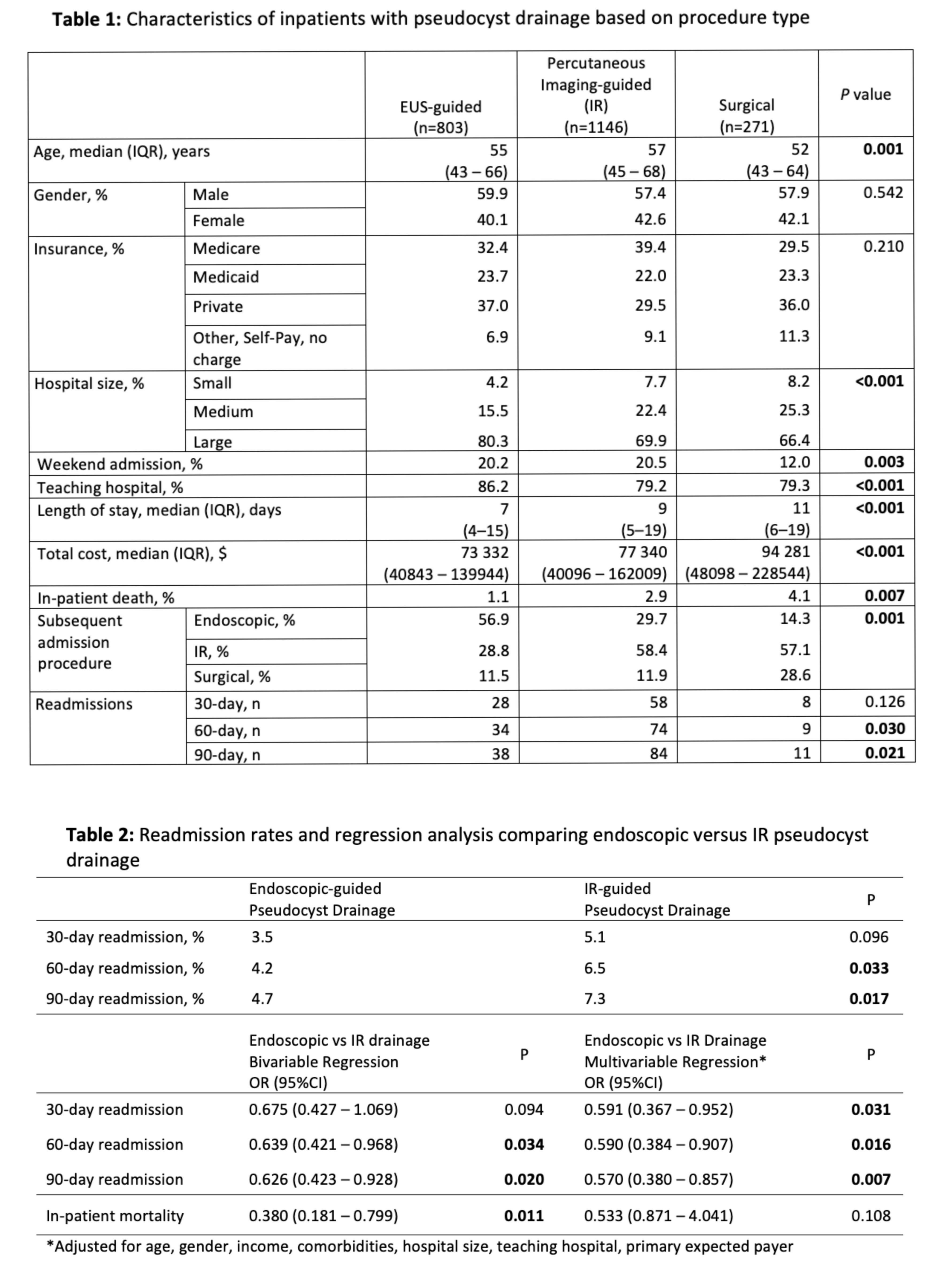Back

Poster Session C - Monday Afternoon
Category: Interventional Endoscopy
C0459 - Readmission Rates Following Endoscopic, Percutaneous, and Surgical Pseudocyst Drainage
Monday, October 24, 2022
3:00 PM – 5:00 PM ET
Location: Crown Ballroom

- TN
Thayer Nasereddin, MD
Allegheny Health Network
Fishers, IN
Presenting Author(s)
Thayer Nasereddin, MD1, Rahul Karna, MD1, Brittany Colosimo, MD1, Manish Dhawan, MD2
1Allegheny Health Network, Pittsburgh, PA; 2Allehengy Health Network, Pittsburgh, PA
Introduction: Endoscopic ultrasound (EUS) transmural pancreatic pseudocyst drainage is increasingly being performed for patients with clinical symptoms. Limited data is known about readmissions rates of such patients when compared to percutaneous and surgical techniques. We aim to assess outcomes and unplanned readmission rates of pancreatic pseudocyst drainage based on type of procedural intervention.
Methods: The National Readmission Database was used to identify all patients in 2016 with pancreatic pseudocyst who underwent endoscopic, percutaneous (IR), or surgical drainage. Patient selection was based on coding in accordance with the ICD-10 CM. The demographic characteristics and inpatient outcomes were calculated for all patients based on procedural type. Bivariate and multivariate logistic regression analysis was performed to identify independent predictors multi-day readmission rates. P value of ≤ 0.05 denotes statistical significance.
Results: Of the 32139 discharges for pancreatic pseudocyst, 2220 underwent pseudocyst drainage: 36.2% were endoscopic, 51.6% were percutaneous, and 12.2% were surgically drained. Of these cases 4.23% required unplanned readmission within ≤30 days: 29.8% were endoscopic, 61.7% were percutaneous, and 8.5% were surgical drainage, p=0.126. Adjustment for the surgical group revealed EUS vs IR-guided drainage had a 30-day readmission rate of 3.5% vs 5.1%, which approached statistical significance, p=0.096. Regression analysis showed index intervention by EUS-guided drainage had decreased risk for unplanned readmission at ≤ 60 days (OR 0.639, p=0.034) and ≤ 90 days (OR 0.626, p=0.02) when compared to the IR-guided group. Adjusted multivariable regression analysis showed patients with endoscopic pseudocyst drainage (aOR 0.591, p=0.031) had an independent decreased risk of unplanned 30-day readmission, Table 2. Multivariable regression analysis showed no statistical significance of inpatient mortality when comparing EUS-guided and IR-guided pseudocyst drainage (p=0.108).
Discussion: Patients undergoing EUS-guided pseudocyst drainage were at lower risk of 30-day readmission after index hospitalization when compared to those receiving IR-guided pseudocyst drainage. Endoscopic intervention also had decreased risk of unplanned readmission at day 60 and 90 after initial discharge. EUS therapy was shown to have an associated shorter hospital stay and decreased healthcare cost. Multi-center randomized control trials will be required to further examine and validate these findings.

Disclosures:
Thayer Nasereddin, MD1, Rahul Karna, MD1, Brittany Colosimo, MD1, Manish Dhawan, MD2. C0459 - Readmission Rates Following Endoscopic, Percutaneous, and Surgical Pseudocyst Drainage, ACG 2022 Annual Scientific Meeting Abstracts. Charlotte, NC: American College of Gastroenterology.
1Allegheny Health Network, Pittsburgh, PA; 2Allehengy Health Network, Pittsburgh, PA
Introduction: Endoscopic ultrasound (EUS) transmural pancreatic pseudocyst drainage is increasingly being performed for patients with clinical symptoms. Limited data is known about readmissions rates of such patients when compared to percutaneous and surgical techniques. We aim to assess outcomes and unplanned readmission rates of pancreatic pseudocyst drainage based on type of procedural intervention.
Methods: The National Readmission Database was used to identify all patients in 2016 with pancreatic pseudocyst who underwent endoscopic, percutaneous (IR), or surgical drainage. Patient selection was based on coding in accordance with the ICD-10 CM. The demographic characteristics and inpatient outcomes were calculated for all patients based on procedural type. Bivariate and multivariate logistic regression analysis was performed to identify independent predictors multi-day readmission rates. P value of ≤ 0.05 denotes statistical significance.
Results: Of the 32139 discharges for pancreatic pseudocyst, 2220 underwent pseudocyst drainage: 36.2% were endoscopic, 51.6% were percutaneous, and 12.2% were surgically drained. Of these cases 4.23% required unplanned readmission within ≤30 days: 29.8% were endoscopic, 61.7% were percutaneous, and 8.5% were surgical drainage, p=0.126. Adjustment for the surgical group revealed EUS vs IR-guided drainage had a 30-day readmission rate of 3.5% vs 5.1%, which approached statistical significance, p=0.096. Regression analysis showed index intervention by EUS-guided drainage had decreased risk for unplanned readmission at ≤ 60 days (OR 0.639, p=0.034) and ≤ 90 days (OR 0.626, p=0.02) when compared to the IR-guided group. Adjusted multivariable regression analysis showed patients with endoscopic pseudocyst drainage (aOR 0.591, p=0.031) had an independent decreased risk of unplanned 30-day readmission, Table 2. Multivariable regression analysis showed no statistical significance of inpatient mortality when comparing EUS-guided and IR-guided pseudocyst drainage (p=0.108).
Discussion: Patients undergoing EUS-guided pseudocyst drainage were at lower risk of 30-day readmission after index hospitalization when compared to those receiving IR-guided pseudocyst drainage. Endoscopic intervention also had decreased risk of unplanned readmission at day 60 and 90 after initial discharge. EUS therapy was shown to have an associated shorter hospital stay and decreased healthcare cost. Multi-center randomized control trials will be required to further examine and validate these findings.

Figure: Tables 1 and 2
Disclosures:
Thayer Nasereddin indicated no relevant financial relationships.
Rahul Karna indicated no relevant financial relationships.
Brittany Colosimo indicated no relevant financial relationships.
Manish Dhawan indicated no relevant financial relationships.
Thayer Nasereddin, MD1, Rahul Karna, MD1, Brittany Colosimo, MD1, Manish Dhawan, MD2. C0459 - Readmission Rates Following Endoscopic, Percutaneous, and Surgical Pseudocyst Drainage, ACG 2022 Annual Scientific Meeting Abstracts. Charlotte, NC: American College of Gastroenterology.
